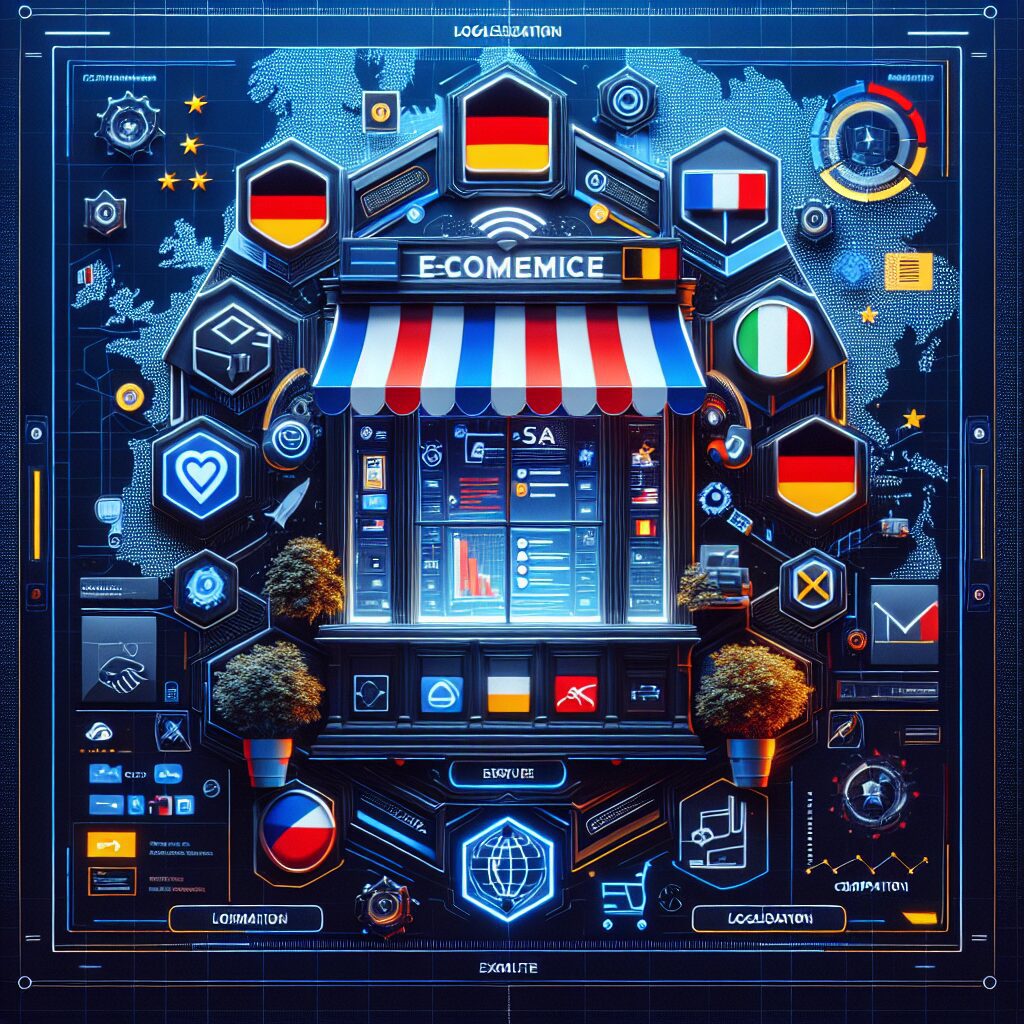About eldris
At Eldris, we automate SEO, multilingual site expansion, and EU compliance for brands scaling across Europe. Our AI-powered platform handles everything from content publishing to regulatory docs—so you don’t have to.
In This Article
- Localise your store per-country using cultural and linguistic best practices.
- Register for VAT in France, Germany, and Italy as needed—automate compliance wherever possible.
- Use multilingual SEO strategies and country-specific keyword research for visibility.
- Optimise checkout flows by integrating region-specific payment methods and logistics partners.
- Deploy automation tools for scalable translations, tax filing, and cross-channel listings.
- Provide customer support in native languages with culturally aware service standards.
- Leverage local marketplaces for trusted brand exposure and increased reach.
- Stay informed of evolving EU directives to maintain compliance and build trust.
Why Sell in France, Germany & Italy?
The EU Consumer Potential Explained
When considering international expansion, few markets are as lucrative and accessible as France, Germany, and Italy. This sell in France guide begins with solid reasons why these nations should be on your eCommerce roadmap. Together, these three countries represent over 210 million consumers with high online shopping penetration and mature eCommerce infrastructure. France alone generates more than €150 billion in annual online sales. German consumers are known for their trust in established online platforms, while Italy’s mobile-first audience presents unique opportunities for digital brands.
Importantly, being part of the European Union simplifies regulatory and logistical frameworks. A single set of regulations through directives like CE marking standards and GDPR offers unified access compared to non-EU regions. Thanks to free movement of goods and services within the EU Single Market, you can establish centralised warehousing, benefit from lower tariffs, and scale your customer base without red tape.
Start-ups and SMEs especially benefit from this harmonisation. Expansion into France, Germany, and Italy is no longer reserved for large enterprises. With cross-border tools and streamlined fulfilment options, international success is increasingly accessible.

Legal Foundations for Cross-Border Selling
Tax ID, CE Marks, and Packaging Compliance
A clear understanding of EU legal benchmarks is essential prior to expansion. For a seller targeting France, this includes ensuring compliance with VAT registration, consumer protection laws, and regional tax regulations. This section of the sell in France guide unpacks the must-know legal pre-requisites. Registering for a French VAT ID is mandatory if your turnover exceeds the country-specific threshold. Moreover, since Brexit, UK sellers must now arrange VAT representation or a fiscal agent within the EU.
Product compliance is another critical area. Goods sold in France, Germany, and Italy often require CE marking—a symbol that verifies a product’s alignment with EU health and safety regulations. For electronics and children’s toys in particular, compliance with EU directives like RoHS and REACH is non-negotiable. Beyond product safety, there are rules regarding environmental packaging and labelling, which vary slightly between markets.
Tackling regional regulations may seem daunting, but with the right counsel and automation tools, compliance becomes scalable. Items like extended producer responsibility (EPR) for packaging and batteries are often overlooked but carry significant penalties when ignored.
“Understanding your statutory footprint and product compliance requirements is not just best practice—it’s essential to building trust with EU consumers.”
Store Localisation Tactics That Work
One-size-fits-all is a misnomer in international ecommerce. In this section of the sell in France guide, we explore how localising your store’s visual language, promotions, and navigation leads to higher conversion rates. French shoppers, for example, prefer formal language and culturally nuanced copy. German users expect precision and transparency, particularly in pricing and delivery details. Italians favour brand storytelling and value-oriented language. Adapt your brand tone to suit each target audience’s expectations.
Visual localisation is also key. Swap out universally generic stock images for culturally relevant assets that resonate with each country’s lifestyle and values. Additionally, using local seasonal references, holidays, and regional events in your on-site promotions can boost user engagement. Formats like “Soldes” (France), “Sconti” (Italy), or “Angebote” (Germany) create familiarity and inspire trust.
Ensure your call-to-actions (CTAs) and checkout flows are fully translated and test them on local devices. From payment methods to form layouts, small UX differences can significantly affect cart abandonment rates. A/B testing across regions is essential to refine your localisation strategy continuously.
Multilingual SEO for EU Visibility
Organic traffic is the backbone of sustained sales in international markets. This sell in France guide highlights that multilingual SEO is not just translation—it’s transcreation. First, use country-specific domains or subdirectories (e.g., .fr for France or /de for Germany) to signal geotargeting to search engines. Then, deploy hreflang tags to indicate language and regional relevance of each page.
Keyword research must be performed individually for each locale. Direct translations from English keywords often miss local search intent or yield poor search volumes. Tools like SEMrush and Ahrefs offer region-specific data. For example, while UK shoppers may search “trainers”, French users type “baskets”, and Italians prefer “scarpe sportive”. These nuances are critical in writing optimised meta descriptions and headings.
Localised blog content, FAQs, and glossary pages further strengthen your SEO strategy while providing valuable customer assistance. Do not neglect voice search optimisation, particularly for mobile-first users in Italy. Ensure your site speed, mobile responsiveness, and schema markups align with regional search engine preferences.
Optimising Payments & Shipping Process
Payment preferences differ widely across the French, German, and Italian markets. This part of the sell in France guide explores options to optimise the checkout process. French consumers often use Carte Bancaire, while Germans favour direct bank transfers and Klarna. Italians are known for using prepaid cards like PostePay. Integrating local gateways and offering a mix of payment types is essential.
Shipping logistics must also be tailored. Offering DPD, La Poste, DHL, or Hermes guarantees timely last-mile delivery. Clearly display delivery timelines and costs—German shoppers, in particular, expect fast and transparent delivery terms. Consider decentralised fulfilment centres or international logistics platforms to reduce lead times and increase regional satisfaction.
Offering free returns and clearly articulated return policies can further drive trust in regions accustomed to consumer-centric rights. Local courier integration improves package tracking and reduces customer service overhead.
Automation Tools for Compliance & Translation
Manual localisation is unsustainable at scale. Therefore, this sell in France guide recommends choosing automation platforms for compliance and translations to maintain operational efficiency. Tools like Weglot or Lokalise facilitate rapid content deployment across multiple languages without duplicative effort. Pair these with real-time sync capabilities to preserve consistency across updates and promotions.
For compliance, solutions such as Avalara or TaxJar can automate VAT calculations, invoice generation, and reporting across jurisdictions. These tools reduce the likelihood of errors and free your team to focus on growth. Centralised dashboards give visibility into regional performance, compliance status, and payment reconciliation.
Automation does not remove the need for human oversight. Ensure that machine translations undergo proofreading by fluent local speakers. Also audit your automated tax filling regularly to stay aligned with ever-evolving EU directives.
Handling Customer Support in Multiple Languages
Great customer service is a competitive differentiator. In multilingual markets, it becomes a business-critical function. This sell in France guide suggests implementing region-specific support channels with native speakers or AI-powered translation layers. French and German shoppers prefer email and live chat, whereas Italian customers often favour WhatsApp or phone support.
Implementing chatbots with multilingual NLP models can manage initial queries and route complex issues to human agents efficiently. Managing this ecosystem via centralised CRMs customised for region-specific workflows and regulations ensures better oversight.
Also, align customer service tone to cultural preferences. French users appreciate formality while Italians often respond better to informal empathy. Training your team on regional etiquette and equipping them with knowledge bases in multiple languages can improve satisfaction rates and retention.
Designing Product Pages for Localised Audiences
Product information must align with each country’s expectations. The sell in France guide recommends reworking imagery, measurements, and description formatting based on region. Use centimetres and kilograms over inches and pounds. Include legally required product information in the local language, especially for items like cosmetics, electronics, and supplements.
Implement user-generated reviews in the respective language to boost credibility. Allow users to filter reviews based on language or region. Local trust badges like “Trusted Shops” in Germany or “FIA-NET” in France can increase on-page conversion. Do not forget accessibility; regionally mandated standards may require alt text or readable font sizes for legal compliance.
Additionally, showcase local pricing inclusive of VAT and offer popups for currency switchers. Localised scarcity triggers—such as “seulement 3 disponibles” or “nur noch 2 auf Lager”—can be powerful for driving urgency.
Choosing the Right Marketplaces
Expanding beyond your website to local marketplaces can accelerate growth. This sell in France guide advises sellers to consider strategic partnerships with platforms like Cdiscount and Fnac in France, Otto in Germany, and ePrice in Italy. Each platform has specific onboarding rules, seller fees, and fulfilment standards that merit careful evaluation.
Integrate your product catalogue via feeds and ensure regular syncing of inventory and price changes. Use middleware platforms such as ChannelEngine or Linnworks for streamlined multichannel listings. Fulfilment by Amazon remains a popular option for cross-border sellers but beware of localisation gaps it might introduce in messaging or support.
Ensure these marketplaces comply with EU directives and that they support your regional VAT registrations and invoicing standards. Remember to read ratings and seller forums like Learn more about European Multilingual E-commerce Expansion to choose the right platform mix.
Pitfalls to Avoid During EU Expansion
Neglecting localisation is a common error documented by seasoned sellers on Read a related article. Using Google Translate for full website translation or adopting one-size-fits-all pricing can result in poor UX and legal penalties. Another mistake is relying on non-EU fulfilment hubs, adding expensive customs and delivery delays post-Brexit.
Fragmented shipping policies, unclear return workflows, and failing to offer local payment methods are all red flags for EU customers. Data privacy violations also remain a high-risk area—ensure GDPR compliance in marketing and site tracking setups with regular audits.
Finally, brands must prepare for evolving EU legislation. Keep up to date via the European Commission website Shopify’s guide for France market entry, and always monitor local press releases for changes impacting eCommerce.
Conclusion: Go Multilingual, Go Global
[CONCLUSION_CONTENT]
Great guide on how-to-prepare-store-sell-in-france-germany-italy – Community Feedback
What are the key legal steps to sell in France, Germany, and Italy?
You must register for tax, meet product compliance (like CE marking), appoint local Responsible Persons if required, and follow packaging/EPR rules. Consult each country’s official requirements for exact steps.
How should I localise my store for French, German, and Italian shoppers?
Translate your site accurately, adjust currency and payment options, follow local customs, and optimise content for local search engines in French, German, and Italian.
What automation tools can help scalably sell across the EU?
AI-powered platforms like Eldris automate translations, compliance documentation, SEO, and site management. This lets brands scale quickly in multiple markets with fewer manual processes.








